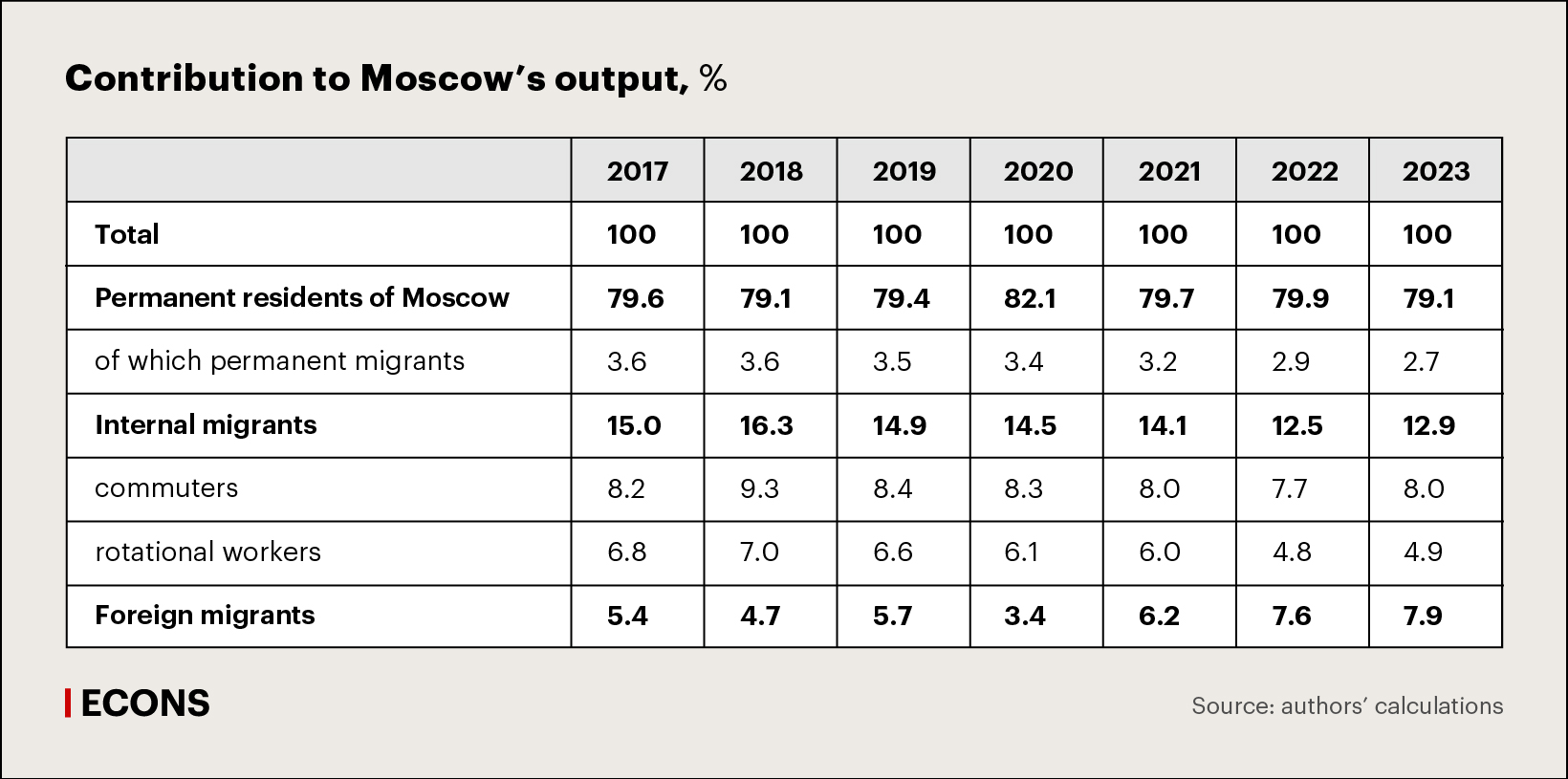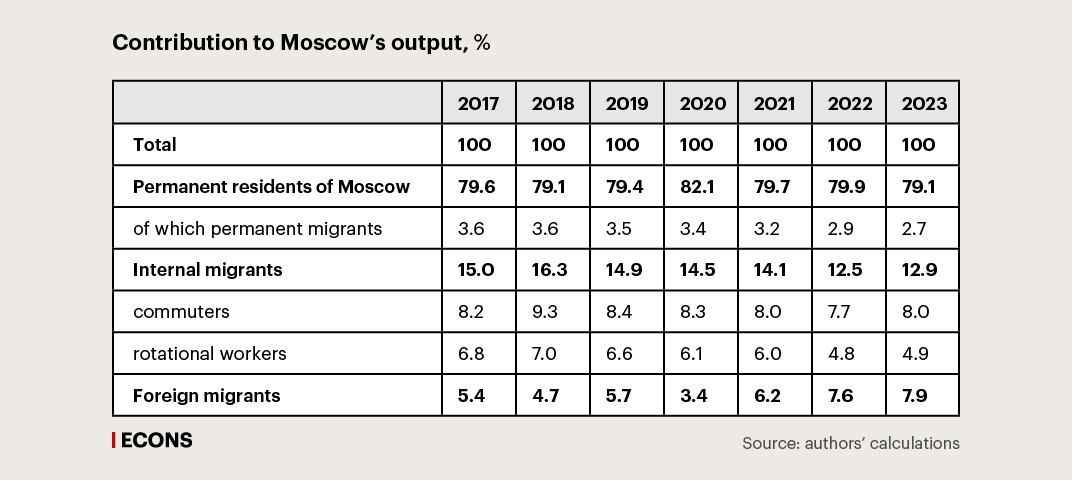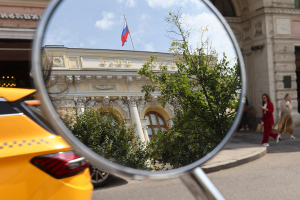Migrant labour is an important contributor to the global economy. Specifically, according to data cited by Achim Steiner, Administrator of the United Nations Development Programme (UNDP), migrants, while constituting only 3.5% of the world’s population, produced 9% of global GDP in 2015. In Russia, the economic role of migrant workers is a subject of extensive public debate. At the same time, there are not as many quantitative assessments showing the significance of migrant labour for both the Russian regions and the country as a whole. Research into labour migration is hampered by problems and limitations associated with the available statistics. Nevertheless, having made a number of assumptions, we estimated the contribution of various categories of migrant workers to Moscow’s gross regional product (GRP) over 2017–2023.
In many countries, migrants are distributed unevenly across the territory, usually clustering in economic hubs with high wages and strong labour demand. In the US, nearly 60% of immigrants (foreign-born individuals) are concentrated in five states – California, Texas, Florida, New York, and New Jersey. In the UK, 41% of immigrants live in London. According to the Main Directorate for Migration of the Russian Ministry of Internal Affairs, in 2023, around 60% of foreign citizens who entered Russia for the purpose of work were registered in four regions – Moscow, the Moscow Region, St Petersburg, and the Leningrad Region. Internal labour migrants, i.e. residents of other Russian regions, are also unevenly distributed across Russia. According to Rosstat, in 2023, nearly 50% of them worked in Moscow.
Moscow is the primary destination for both foreign and internal migrants in Russia, making it the most logical choice for analysing migration processes from an economic perspective. In addition, detailed statistical information on various categories of migrants is available for Moscow, unlike most other regions. These data allowed us to analyse the contribution of not only foreign migrants, but also internal migrants – namely, commuters and rotational workers.
Our study based on Rosstat data and the results of a survey of nearly 5,000 labour migrants in Moscow distinguishes five groups of employed persons:
- permanent residents of Moscow;
- permanent migrants (included in the group of permanent residents), i.e. residents of Moscow who relocated to Moscow for permanent residence over the past five years;
- commuters, i.e. those working in Moscow, but permanently residing in other constituent territories of the Russian Federation, making daily trips home;
- rotational workers, i.e. those working in Moscow but permanently residing in other constituent territories of the Russian Federation, making trips home once a week or less frequently;
- foreign labour migrants, i.e. foreign citizens who have entered Russia for a certain period for employment purposes.
Following international practice, we estimated migrants’ contribution to output in accordance with their share in total labour remuneration. The key premise of this approach is that remuneration is proportional to productivity, and consequently, to the contribution to output made by different groups of workers.
According to our estimates, the total contribution of all migrant categories to Moscow’s GRP reached 23–25% over 2017–2023. More than half of this contribution was made by internal migrants, that is, commuters and rotational workers, although the significance of foreign labour migrants has been increasing in recent years.
Sectoral differences
According to our estimates, the highest contribution, i.e. around 80% of Moscow’s output, is predictably accounted for by the city’s permanent residents. This includes the 3–4% of output provided by permanent migrants who moved to Moscow over the past five years.
Permanent residents of Moscow account for 90–92% of output in the social sector (education, healthcare, culture and sports), for 85–90% in finance and insurance, as well as professional services, and for over 80% in information and communications, as well as manufacturing. Permanent residents make the lowest contribution in the construction sector, where it consistently remained below 50% over 2017–2023.



Commuters, many of whom are residents of the Moscow Region, occupy the second place in terms of their significance for the city’s economy, accounting for around 8–9% of its output. Their contribution is particularly notable in information and communications, professional services, manufacturing, as well as transportation and storage (about 10% of the total contribution). A large proportion of commuters have higher education – around 60%, which is even higher than among employed permanent residents of Moscow (50%). This enables them to occupy positions in sectors requiring professional expertise. Specifically, more than half of commuters are managers and highly qualified specialists.
Rotational workers are significant contributors to Moscow’s construction and administrative activities, on average providing about 20–30% of output in these sectors. However, their overall contribution to the city’s economy has been contracting, dropping from 7% in 2018 to just 4.9% in 2023. Half of rotational workers are employed in services, trade, security, and as highly qualified specialists in industrial production, construction, and transport. Their role in information and communications, finance, and professional services is minimal (1–3% of the city’s output), which correlates with a relatively low percentage of individuals with higher education among them (approximately 22%).
Over 2017–2019, the contribution of foreign migrants to Moscow’s output was the smallest (5–6% of GRP), compared to that of other categories of workers, reaching its lowest level (3.4%) in 2020 during the COVID-19 pandemic. However, since 2021, there has been an upward trend in their contribution that reached 7.9% in 2023, thereby surpassing that of rotational workers (4.9%) and nearly equalling that of commuters (8%). Taking into account illegal migration, the estimates of the annual contribution of foreign migrants are almost 1 pp higher.
International migrants make their largest contribution in the construction sector (15% to 33% of Moscow’s GRP in different years), trade (6–12%), and other industries (5–14%, primarily in energy, water, agriculture, as well as hotel and public catering sectors), but have a very limited presence in the social sector or professional services. It should be noted, however, that data on employed foreign migrants is of poor quality, and therefore, these findings should be interpreted with caution.
Conclusions
As shown by our estimates, migrants represent a significant labour resource for Moscow’s economy. In 2017–2023, the total contribution of commuters, rotational workers, and foreign migrants to output exceeded 20%, reaching as high as 25% taking into account permanent migrants who had moved to Moscow over the past five years. The year 2020 constituted an exception as the COVID-19 restrictions caused a considerable drop in the number of employed migrants, reducing their total contribution by almost 3 pp.
The role of migrants varies significantly across different types of economic activity. The city’s construction sector is the most dependent on migrants who contribute more than 60% to its output, with over half of this contribution accounted for by foreign migrants. The situation is quite the opposite in sectors demanding high qualifications, such as IT and communications, finance and insurance, and professional services and research, where the total contribution of migrants to Moscow’s output does not exceed 15% and is primarily generated by commuters. Within industries, there is a division of labour among different groups of migrant workers, reflecting the specific aspects of the production process.
Comparable estimates of migrant labour’s contribution to output, similar to those for Moscow, have been obtained for London and New York, showing contribution of around 22%. However, foreign studies of the economic contribution of migrants typically focus on immigrants, i.e. foreign-born individuals who have relocated to host countries for permanent residence. The significant role of internal migration, as well as temporary (rather than permanent) international migration, in the labour market is what sets Moscow apart from many other global cities.
The full text of the study is published in the journal Voprosy Ekonomiki, 2025, No. 10.









